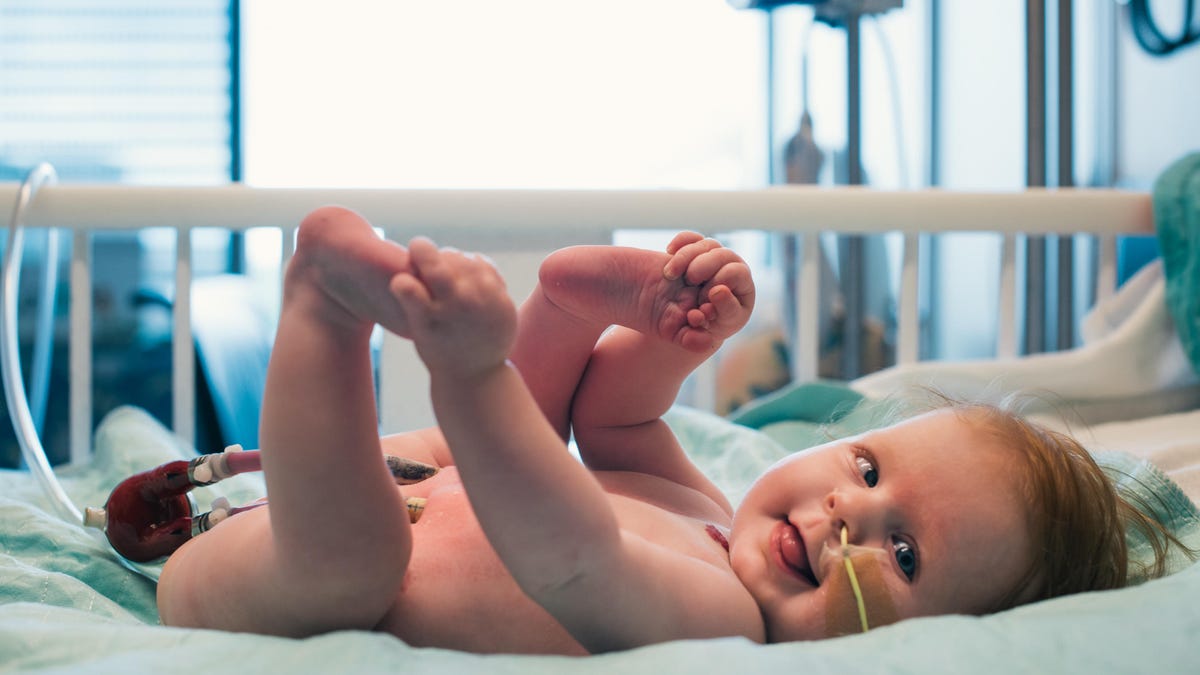This artificial heart can save the youngest patients
From CNET Magazine: Medical advances can keep the tiniest hearts beating.

Seven-week-old Juniper Gelrod lay in the cardiac intensive care unit at Children's Hospital Colorado after being diagnosed with dilated cardiomyopathy. That means the enlarged muscles in her heart are too weak to pump blood through her body.
She's classified 1A on the heart transplant list, a ranking reserved for patients who aren't expected to survive more than 30 days without a new heart. It's April 2014, and Juniper is getting sicker by the day.
"They're really just trying to buy time," Cole Gelrod, Juniper's dad, tells me years later. "As much time as you can buy would be good."
To buy that time, Juniper's doctors implanted a Berlin Heart — a ventricular assist device (VAD) system that helps the smallest, sickest babies survive until a new heart becomes available.
VAD systems — which combine surgically inserted pumps with external controls and power supplies — have come a long way since 1963, when famed cardiac surgeon Dr. Michael DeBakey implanted the first such device. VADs have since become smaller, less obtrusive and easier to wear. More than a half-dozen devices have been approved for sick adults who need a stopgap to keep them alive while waiting for a transplant. Super small babies don't have those options.
The Berlin Heart could eventually be joined by the Infant Jarvik 2015, currently undergoing preclinical testing. Why so few options for young children? It's a question of numbers: There were only 9,566 pediatric heart transplants from 1982 to 2009, according to a 2010 report from the Registry of the International Society for Heart and Lung Transplantation.
"The idea behind these pumps is to preserve any other organs so the heart transplant can go as smoothly as possible," says Dr. Scott Auerbach, a cardiologist and the medical director of the VAD program at Children's Hospital Colorado. "If the kidney, lungs, liver and brain aren't functioning well, the transplant's not going to go well."
Quality of life
The Berlin Heart pediatric VAD consists of two tubes attached directly to the baby's heart, which then extend out through the skin to a pump that's connected to a 200-pound machine the size of an old-school ice cream cart.
That machine drives air into and out of the pump to pull blood from the left ventricle and send that blood to the aorta — a constant cycle that handles the work normally done by a healthy heart.
Most patients use the device for more than 30 days, says Dr. David Rosenthal, a pediatric cardiologist at Lucile Packard Children's Hospital Stanford, in Palo Alto, California.
Rosenthal, who wasn't involved in Juniper's surgery, works with one of the largest pediatric VAD and heart transplant programs in the US. He says the Berlin Heart plays a key role in getting children with severe heart failure stable enough for a transplant.
"In children, we are nearly always using [VADs] to get them to be a better transplant candidate," he says.
Cole Gelrod cradles his daughter on their way back from the operating room.
The median waiting time for a heart for an infant under 1 year old is 108 days, according to the United Network for Organ Sharing.
At nearly 2 months old, Juniper was the Colorado hospital's youngest patient to get the Berlin Heart. Her parents thought long and hard about whether to put their newborn baby through the trauma of being hooked to a machine — with the very real risk of strokes — most likely for months.
"We kind of grappled with the decision for a while," Gelrod tells me. "We didn't want to save our kid just to save our kid if she wasn't going to have a good quality of life."
Juniper's heart
The days leading up to Juniper's VAD implant were dire. Drugs traditionally used to treat babies with her condition just weren't working. She was dying.
Juniper's only hope, her doctors said, was being hooked to that big piece of hardware until she could get a transplant. There are many risks associated with putting a baby as tiny as Juniper on the Berlin Heart, including blood clots, serious infections and strokes. But the risk of not putting her on it was even greater.
Gelrod recalls the doctors saying, "The odds are 50-50, but we'll know pretty quick if it's going to work. And if it is, she'll actually be a lot healthier than she is now."
Juniper did have four strokes within the first two weeks of being attached to the pediatric VAD.
Juniper remained sick for the five months she was connected to the 200-pound machine, but she was eventually able to play with toys and watch TV with her parents.
See more great stories from CNET Magazine.
Her parents got the call they'd been waiting for on Sept. 17, 2014. Their daughter had been on the transplant list for 194 days. She was 7 months old.
Today, Juniper's a happy 4-year-old who loves to swim, play soccer and do anything that involves being around her dog, Otis.
The main long-term concern with any transplant is organ rejection. She'll take two medications daily for the rest of her life to prevent her body from attacking her heart. Doctors check annually for rejection, but Juniper hasn't had any issues so far.
"We credit that device for saving her life because she wouldn't have made it to transplant without it," Gelrod says. "She went from being on the verge of death to being able to take walks in the hospital every day.
"She's pretty much a normal kid."
Kaitlin Benz (@Kaitlin_Benz) is a freelance writer in San Francisco.
This story appears in the winter 2018 edition of CNET Magazine. Click here for more magazine stories.